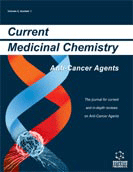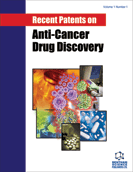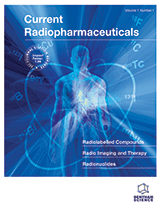Abstract
Aminophosphonic acids were almost unknown in 1959 but today they are the subject of more than 6000 papers. Their negligible mammalian toxicity, and the fact that they very efficiently mimic aminocarboxylic acids makes them extremely important antimetabolites, which compete with their carboxylic counterparts for the active sites of enzymes and other cell receptors. Although biological importance of these compounds was recognized over 50 years ago they still represent promising and somewhat undiscovered class of potential drugs.
Current Medicinal Chemistry - Anti-Cancer Agents
Title: Aminophosphonic Acids of Potential Medical Importance
Volume: 1 Issue: 3
Author(s): Pawel Kafarski and Barbara Lejczak
Affiliation:
Abstract: Aminophosphonic acids were almost unknown in 1959 but today they are the subject of more than 6000 papers. Their negligible mammalian toxicity, and the fact that they very efficiently mimic aminocarboxylic acids makes them extremely important antimetabolites, which compete with their carboxylic counterparts for the active sites of enzymes and other cell receptors. Although biological importance of these compounds was recognized over 50 years ago they still represent promising and somewhat undiscovered class of potential drugs.
Export Options
About this article
Cite this article as:
Kafarski Pawel and Lejczak Barbara, Aminophosphonic Acids of Potential Medical Importance, Current Medicinal Chemistry - Anti-Cancer Agents 2001; 1 (3) . https://dx.doi.org/10.2174/1568011013354543
| DOI https://dx.doi.org/10.2174/1568011013354543 |
Print ISSN 1568-0118 |
| Publisher Name Bentham Science Publisher |
Online ISSN 1875-5968 |
 5
5Related Articles
-
Oxidative Stress Upregulates PDCD4 Expression in Patients with Gastric Cancer via miR-21
Current Pharmaceutical Design Reducible Disulfide-Based Non-Viral Gene Delivery Systems
Mini-Reviews in Medicinal Chemistry Perspectives on Sesquiterpene Lactones in Inflammation and Cancer
Current Drug Targets Understanding the Use of Immunosuppressive Agents in the Clinical Management of IBD
Current Drug Targets Mesenchymal Stem Cells: New Approaches for the Treatment of Neurological Diseases
Current Stem Cell Research & Therapy Integrins: Regulators of Tissue Function and Cancer Progression
Current Pharmaceutical Design Immunotherapy for Prostate Cancer
Current Pharmaceutical Design Bioenergetics and Mitochondrial Dysfunction in Aging: Recent Insights for a Therapeutical Approach
Current Pharmaceutical Design Biosafety Considerations Using Gamma-Retroviral Vectors in Gene Therapy
Current Gene Therapy Plasma-Free Amino Acid Profiling of Nasal Polyposis Patients
Combinatorial Chemistry & High Throughput Screening One Special Question to Start with: Can HIF/NFkB be a Target in Inflammation?
Endocrine, Metabolic & Immune Disorders - Drug Targets MEK Inhibitors: A Therapeutic Approach to Targeting the Ras-MAP Kinase Pathway in Tumors
Current Pharmaceutical Design Chemistry and Pharmacology of Bioactive Molecule -Coenzyme Q10: A Brief Note
Current Bioactive Compounds Soy Isoflavones and Exercise: Possible Benefits for Postmenopausal Womens Cardiovascular Health
Current Women`s Health Reviews Infectious Co-Factors in HIV-1 Transmission Herpes Simplex Virus Type-2 and HIV-1: New Insights and Interventions
Current HIV Research Moving to the Rhythm with Clock (Circadian) Genes, Autophagy, mTOR, and SIRT1 in Degenerative Disease and Cancer
Current Neurovascular Research TNF alpha Inhibition as Treatment Modality for Certain Rheumatologic and Gastrointestinal Diseases
Endocrine, Metabolic & Immune Disorders - Drug Targets PET/CT and the Response to Immunotherapy in Lung Cancer
Current Radiopharmaceuticals Modulation of Neutrophil Development and Homeostasis
Current Molecular Medicine Clearance of Beta-Amyloid in the Brain
Current Medicinal Chemistry


















